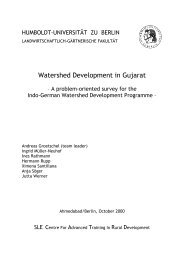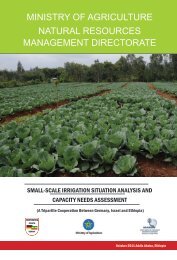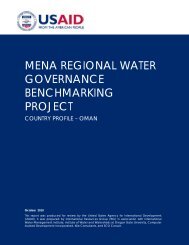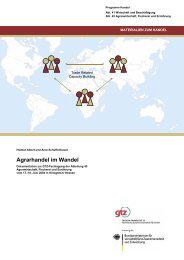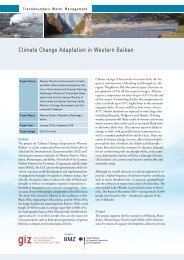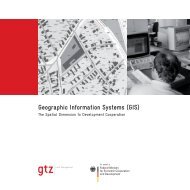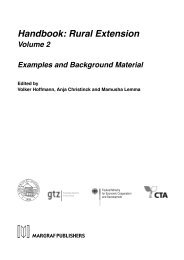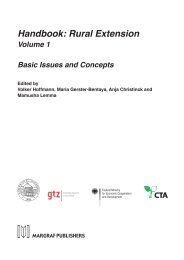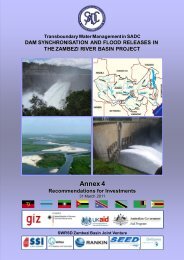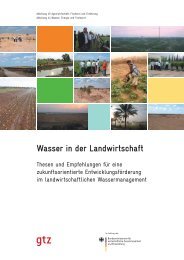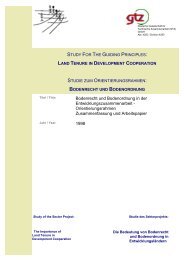Farming in the - WordPress.com
Farming in the - WordPress.com
Farming in the - WordPress.com
Create successful ePaper yourself
Turn your PDF publications into a flip-book with our unique Google optimized e-Paper software.
56<br />
Analysis of <strong>the</strong> agricultural situation <strong>in</strong> Azraq Bas<strong>in</strong><br />
German-Jordanian Programme “Management of Water Resources”<br />
7.2.1. – Proposition of<br />
crops more suitable to<br />
environmental conditions<br />
Based on bibliography, we can<br />
highlight that some crops seem to<br />
be well adapted to water thrifty<br />
conditions. Almond has very low<br />
water needs and is a marketable<br />
product 27 (water requirements<br />
estimated <strong>in</strong> <strong>the</strong> Jordan River<br />
Bas<strong>in</strong> are 380 m 3 /du for soft shell<br />
almonds, 350 m 3 /du for hard shell<br />
almonds, while olive trees need<br />
400 m 3 /du <strong>in</strong> <strong>the</strong> same conditions).<br />
The desert- type jojoba trees have<br />
<strong>the</strong> lowest water needs amongst<br />
all trees (300 m 3 /du).<br />
Table 3: Crop water requirements, accord<strong>in</strong>g to different bibliography<br />
sources<br />
Crop<br />
Tomato<br />
Cauliflower and cabbage<br />
O<strong>the</strong>r vegetables<br />
Watermelon<br />
Sweet melon<br />
Average on vegetables<br />
Olive<br />
Apple<br />
Peach<br />
Grape<br />
O<strong>the</strong>r stone fruits<br />
O<strong>the</strong>r deciduous trees<br />
Average on orchards<br />
(olive excluded)<br />
Date palm<br />
Jojoba<br />
Almond (soft shell /<br />
hard shell)<br />
Alfalfa<br />
Vetch<br />
Mafraq regionm 72<br />
(Eastern desert area)<br />
m 3 /du<br />
750<br />
500<br />
750<br />
415<br />
580<br />
600<br />
690<br />
1060<br />
1000<br />
1040<br />
1045<br />
1000<br />
1030<br />
Total water needs <strong>in</strong> <strong>the</strong><br />
Jordan River Bas<strong>in</strong> 73<br />
m 3 /du<br />
550<br />
450<br />
400<br />
400 (apricot)<br />
1500<br />
300<br />
380 / 350<br />
400<br />
325<br />
Type of vegetable<br />
Water needs for<br />
vegetables <strong>in</strong>side a<br />
greenhouse<br />
72 Net crop water requirement (<strong>in</strong> m3/du/year) <strong>in</strong> amman Zarqa bas<strong>in</strong> (adapted from Fitch 2001). The net requirement is <strong>the</strong> total crop requirement divided by an<br />
estimated 80 percent efficiency for drip irrigation <strong>in</strong> <strong>the</strong> Amman bas<strong>in</strong>. In Irrigated agriculture, water pric<strong>in</strong>g and water sav<strong>in</strong>gs <strong>in</strong> lower Jordan River Bas<strong>in</strong>, JP Venot, 2007<br />
73 Tomatoes<br />
600<br />
1000<br />
Total water needs, or ra<strong>in</strong>fall requirements for economic production. In A water for peace strategy for <strong>the</strong> Jordan River by shift<strong>in</strong>g cropp<strong>in</strong>g patterns, Said A. Assaf, 2007<br />
Cucumbers<br />
850<br />
Water needs for<br />
vegetables <strong>in</strong>side a<br />
greenhouse<br />
1200



